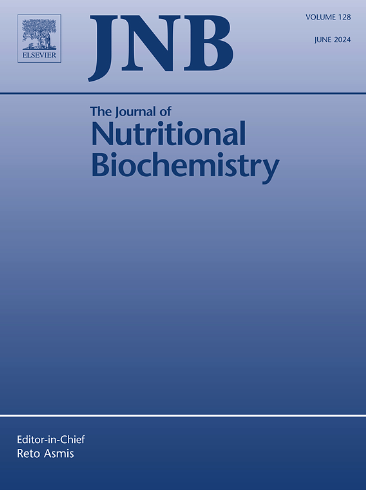血液 DNA 甲基化、饮食质量指数和代谢健康之间的关系:来自 Obekit 研究的数据。
IF 4.8
2区 医学
Q1 BIOCHEMISTRY & MOLECULAR BIOLOGY
引用次数: 0
摘要
表观遗传机制可受饮食因素的调节,已被认为是了解个体间疾病易感性差异的一个可能因素。我们旨在确定西班牙人 DNA 甲基化(DNAm)、饮食质量和代谢健康之间的关系。这是一项横向研究,涵盖了参加 Obekit 研究的 337 名男性和女性参与者。膳食质量采用经过验证的半定量食物频率问卷和之前确定的七项评分进行评估:总体、健康和不健康植物性膳食指数(分别为 PDI、hPDI 和 uPDI)、膳食多样性评分(DDS)、未加工/微加工食品(MPF)和超加工食品(UPF)消费量以及地中海饮食(MD)评分。使用Infinium MethylationEPIC v1.0 BeadChip试剂盒对白细胞中的DNAm进行分析。经过方差大于 0.36 的筛选后,我们发现了 5,261 个 CpG 位点。我们发现营养素与 CpGs 位点之间存在四个假发现率 (FDR) 显著相关性:cg00167275(GLUD1)与酒精相关,cg05218090 与叶酸相关,cg16682935(PAPSS2)与硒相关,cg09821790(SLC7A6)与鱼类食物相关。位于锌指蛋白基因 57(ZFP57)的一个差异甲基化区域(DMR)与肥胖、特定营养素、食物组和膳食质量指数密切相关。基于 DNAm 的膳食质量回归模型显示,UPF 和 hPDI 的预测价值最高。此外,UPF 和 hPDI 也是预测主要心脏代谢风险因素的最佳指数。我们的研究结果表明,特定的营养素和饮食质量指数可能会影响 DNAm 的程度,进而影响西班牙人的代谢健康。本文章由计算机程序翻译,如有差异,请以英文原文为准。
Relationship between blood DNA methylation, diet quality indices and metabolic health: Data from Obekit study
Epigenetic mechanisms, which can be modulated by dietary factors, have been proposed as a possible factor in understanding interindividual differences in disease susceptibility. We aimed to determine the relationships between DNA methylation (DNAm), diet quality, and metabolic health in Spanish individuals. This is a transversal study encompassing 337 male and female participants in the Obekit study. Diet quality was assessed using a validated semiquantitative food frequency questionnaire and seven previously established scores: overall, healthy and unhealthy Plant-Based Diet Index (PDI, hPDI and uPDI, respectively), dietary diversity score (DDS), unprocessed/minimally processed foods (MPF) and ultra-processed foods (UPF) consumption and Mediterranean diet (MD) score. DNAm was analyzed in white blood cells using the Infinium MethylationEPIC v1.0 BeadChip kit. After filtering by a variance >0.36, we have worked with 5,261 CpG sites. We found four false discovery rate (FDR)-significant correlations between nutrients and CpGs sites: cg00167275 (GLUD1) correlated with alcohol, cg05218090 with folic acid, cg16682935 (PAPSS2) with selenium, and cg09821790 (SLC7A6) with fish food. One differentially methylated region (DMR) located at zinc finger protein gene 57 (ZFP57) was closely related to obesity and specific nutrients, food groups, and diet quality indices. The regression models of diet quality based on DNAm demonstrated that the most predictive values were when UPF and hPDI were considered. Also, UPF and hPDI were the best indices for predicting the main cardiometabolic risk factors. Our finding suggests that specific nutrients and diet quality indices may influence the degree of DNAm and putatively, the metabolic health in Spanish individuals.
求助全文
通过发布文献求助,成功后即可免费获取论文全文。
去求助
来源期刊

Journal of Nutritional Biochemistry
医学-生化与分子生物学
CiteScore
9.50
自引率
3.60%
发文量
237
审稿时长
68 days
期刊介绍:
Devoted to advancements in nutritional sciences, The Journal of Nutritional Biochemistry presents experimental nutrition research as it relates to: biochemistry, molecular biology, toxicology, or physiology.
Rigorous reviews by an international editorial board of distinguished scientists ensure publication of the most current and key research being conducted in nutrition at the cellular, animal and human level. In addition to its monthly features of critical reviews and research articles, The Journal of Nutritional Biochemistry also periodically publishes emerging issues, experimental methods, and other types of articles.
 求助内容:
求助内容: 应助结果提醒方式:
应助结果提醒方式:


